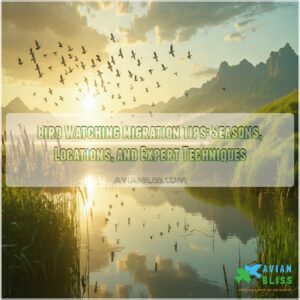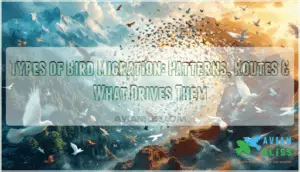This site is supported by our readers. We may earn a commission, at no cost to you, if you purchase through links.
Tracking bird migration has come a long way with modern tools.
GPS and satellite tags map precise routes across continents, while light-level geolocators are perfect for smaller birds.
Radio telemetry uses receiver stations to track movements over long distances.
For real-time insights, citizen scientists contribute sightings to platforms like eBird, creating a global migration database.
Even Doppler weather radar (NEXRAD) helps visualize massive bird movements across North America.
These bird migration tracking methods reveal fascinating patterns as well as guide conservation efforts.
Each tool offers unique insights—ever wonder how we connect migration data to preserving habitats?
Stay tuned.
Table Of Contents
- Key Takeaways
- Bird Migration Basics
- Tracking Technologies Overview
- Data Collection Methods
- Analyzing Migration Data
- Frequently Asked Questions (FAQs)
- How does bird tracking work?
- How can eBird be used to track bird migration?
- How do you track birds over long distances?
- Can a radio transmitter track a migrating bird?
- How does the Internet help migratory bird research?
- Can technology help protect migratory birds?
- How are bird migrations tracked?
- What methods do scientists use to monitor bird migration?
- How is migration tracked?
- What method is used to study bird migration?
- Conclusion
Key Takeaways
- You can track bird migrations with tools like GPS tags, geolocators, and satellite tracking for precise mapping across continents.
- Citizen scientists play a vital role by logging sightings on platforms like eBird, creating a global migration database.
- Threats like habitat loss and climate change call for conservation efforts, like preserving stopover sites and advocating for wildlife policies.
- Data analysis tools, including mapping and route modeling, help uncover patterns and inform strategies to protect birds’ journeys.
Bird Migration Basics
Bird migration is a remarkable natural event where birds travel vast distances to find food, breed, or escape harsh weather.
Understanding these journeys helps highlight the challenges they face and the importance of protecting their habitats.
Migration Patterns and Drivers
Bird migration is driven by survival instincts.
Migratory species follow specific bird migration routes, chasing food sources, ideal breeding habits, and adapting to changing daylight hours.
Climate change and unpredictable weather patterns often disrupt these migration patterns, making journeys harder.
Avian migration showcases nature’s balance, as birds rely on cues like celestial navigation to traverse vast distances with precision and purpose, highlighting the importance of nature’s balance.
Importance of Conservation Efforts
Protecting migratory birds isn’t just about saving species—it’s about preserving ecosystems we all depend on.
Conservation biology emphasizes habitat preservation and sustainable practices to guarantee safe stopovers and breeding grounds.
Here’s how you can support bird conservation:
- Advocate for habitat conservation and wildlife protection policies.
- Participate in citizen science projects like eBird.
- Reduce pesticide use to safeguard biodiversity and ecosystem services.
Threats to Migrating Birds
While bird conservation efforts matter, migrating species face real threats.
Habitat loss squeezes their stopovers, while window collisions claim millions yearly, and climate change shifts food sources, leaving birds stranded.
Predator control, like managing free-roaming cats, is critical too, and human disturbance disrupts migration routes, making habitat conservation essential.
Wildlife tracking technology helps us understand and protect these delicate journeys before it’s too late, and effective bird migration habitat conservation requires understanding migratory bird conservation strategies to preserve species.
Tracking Technologies Overview
Understanding how birds travel incredible distances starts with the tools we use to follow their journeys, including bird tracking devices that have come a long way, making migration monitoring more precise than ever.
Wildlife tracking technology like GPS tracking systems and satellite tracking helps researchers map routes across continents, while for smaller birds, light-level geolocators offer insights, though they’re less accurate.
Radio telemetry, including the Motus system, uses receiver stations to track tagged birds without needing constant monitoring, and these bird tracking devices rely on sensor technology and data transmission to reveal patterns we’d never see otherwise.
Each method has its strengths, from pinpointing exact locations to covering vast areas, and together, these tools reveal the secrets of migration and guide conservation efforts worldwide.
Effective bird migration habitat conservation strategies, such as habitat conservation efforts, are vital for protecting migratory bird species and their habitats.
Data Collection Methods
To track bird migration effectively, you need reliable methods to gather accurate data on their movements.
Techniques like banding, radio telemetry, satellite tracking, and genetic studies provide essential insights into migration patterns and species behavior.
Banding and Radio Telemetry
Shifting from advanced tracking tools, let’s talk about banding and radio telemetry—two classics in bird tracking.
Banding uses lightweight rings to ID birds, revealing migration routes and lifespans.
Radio telemetry, with tiny transmitters, sends radio signals to tracking systems, enabling wildlife monitoring over long distances.
Understanding bird migration patterns is essential for effective conservation efforts.
- Affordable and effective bird marking tools
- Telemetry devices track remote movements
- Boosts wildlife monitoring insights
Satellite Tracking and Geolocators
Satellite telemetry revolutionizes tracking animal movement, offering location data without retrieving devices.
Systems like Argos analyze satellite signals, while GPS satellite telemetry logs precise routes.
Geolocator devices, or light-level geolocators, estimate positions using sunlight patterns.
Modern tracking technologies, using satellite tracking of animals, allow researchers to gather continuous data on animal movements over vast distances.
These compact tools suit small birds but require recapture for data.
Together, these tracking systems reveal migration mysteries, advancing conservation efforts globally.
Genetic Connectivity Studies
Ever wonder how scientists uncover bird migration patterns?
Genetic connectivity studies use genetic markers to trace migratory connectivity, revealing breeding sites and stopovers.
Think of it like ancestry tests for birds!
By analyzing migration genetics and bird phylogeny, researchers track species isolation and population dynamics.
This method sharpens bird migration tracking, helping protect critical habitats and guarantee survival.
The use of Genetic Testing kits has become essential in understanding the genetic makeup of various bird species.
Analyzing Migration Data
To make sense of bird migration, you analyze data that tracks their movements across vast distances.
This process involves mapping routes, identifying patterns, and addressing gaps to better understand their journeys and inform conservation strategies.
Data Aggregation and Mapping
Bird migration tracking thrives on mapping tools and data visualization.
Hexagon mapping simplifies spatial modeling by breaking vast areas into manageable chunks.
Location connections maps link bird movements, revealing migration hotspots.
By layering species tracking data, you can uncover patterns others might miss.
These mapping methods help transform raw data collection into actionable insights for conservation and research.
Effective use of Bird Mapping tools is essential for analyzing migration patterns.
- Hexagon Mapping: Simplifies vast migration data.
- Location Connections Maps: Tracks movement between regions.
- Data Visualization: Makes complex patterns easier to interpret.
- Mapping Tools: Combine species tracking with spatial modeling.
Interpreting Migration Routes and Patterns
When analyzing bird migration, it’s all about decoding flight pathways and migration patterns.
Birds navigate using celestial cues, magnetic fields, and mental maps, often following habitat corridors or avoiding tough terrain.
Route analysis and pattern recognition reveal how migratory species adapt their journeys, which is crucial for understanding their migration patterns and survival strategies.
These tracking methods help refine migration modeling, ensuring specialists comprehend their survival strategies and critical stopovers.
Recognizing Data Gaps and Limitations
Tracking bird migration isn’t perfect—data quality issues, sampling biases, and spatial errors often complicate things.
Smaller species or short-distance migrants are underrepresented due to technology limitations in telemetry systems.
Gaps arise in remote areas or overwater routes, where research challenges persist.
Habitat loss threats, caused by deforestation and fragmentation, substantially impact essential stopover sites for migrating birds.
By combining tracking technology, acoustic monitoring, and data from multiple sources, bird migration research can bridge these gaps effectively.
Bird migration habitat conservation is imperative for protecting these essential stopover sites, which are critical for migrating birds and require effective conservation to prevent further habitat loss.
Frequently Asked Questions (FAQs)
How does bird tracking work?
Nearly 38,000 animals are tracked globally using Motus, a network of receiver stations.
You’ll find birds fitted with tiny devices like GPS tags or geolocators, which send location data to reveal migration routes and behaviors.
How can eBird be used to track bird migration?
You can use eBird to log your bird sightings, track migration trends, and explore real-time data shared by birders worldwide.
Its interactive maps and tools make spotting patterns and contributing to research both fun and impactful.
How do you track birds over long distances?
Let’s face it—birds don’t carry GPS by choice.
You’ll rely on satellite trackers, radio telemetry, or geolocators.
These tools map their epic journeys, revealing routes and stopovers critical for understanding and protecting them, which involves using geolocators.
Can a radio transmitter track a migrating bird?
Yes, a radio transmitter can track a migrating bird.
It sends signals to receiver stations, like the Motus network, letting researchers follow the bird’s journey without needing to physically track it every step.
How does the Internet help migratory bird research?
The internet connects researchers and citizen scientists worldwide, making bird migration data accessible in real-time.
This accessibility is facilitated by platforms like eBird and BirdCast, which let you track patterns, share observations, and contribute to global efforts to protect migratory birds.
Can technology help protect migratory birds?
Imagine a digital safety net for birds—technology does just that.
From tracking migration routes with GPS to forecasting threats like storms or habitat loss, it helps you protect these travelers and their fragile ecosystems.
How are bird migrations tracked?
You track bird migrations using tools like GPS trackers, radio telemetry, and banding.
Scientists also analyze data from citizen science projects, satellites, and geolocators, unraveling epic bird journeys to better protect these incredible travelers, involving bird migrations.
What methods do scientists use to monitor bird migration?
Scientists band birds, attach GPS trackers, or use lightweight geolocators to monitor migrations.
They also rely on radar, satellite tracking, and Motus networks, combining tech and observation to uncover the secrets behind birds’ incredible journeys.
How is migration tracked?
You can follow bird migrations using tools like GPS trackers, tiny radio transmitters, and geolocators.
Observers also track movements through citizen science platforms like eBird, blending advanced tech with human curiosity to uncover nature’s incredible journeys.
What method is used to study bird migration?
You’ll find bird migration studied using tech like GPS trackers, light-level geolocators, and radio telemetry.
Researchers also rely on good old-fashioned banding, citizen science, and satellite tracking to uncover their incredible journey across the skies.
Conclusion
It’s ironic how the tiniest birds can traverse continents, yet tracking their flights takes some of humanity’s most advanced tools.
From GPS tags to citizen scientist contributions, modern bird migration tracking methods reveal routes, risks, and essential stopovers.
This data isn’t just fascinating—it’s key to protecting species under threat, by understanding where birds travel and why, you’re helping preserve ecosystems that sustain us all.
So, let’s keep learning and supporting these incredible journeys.








